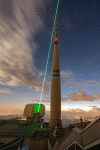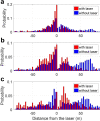Laser-guided lightning
- PMID: 36909208
- PMCID: PMC9988683
- DOI: 10.1038/s41566-022-01139-z
Laser-guided lightning
Abstract
Lightning discharges between charged clouds and the Earth's surface are responsible for considerable damages and casualties. It is therefore important to develop better protection methods in addition to the traditional Franklin rod. Here we present the first demonstration that laser-induced filaments-formed in the sky by short and intense laser pulses-can guide lightning discharges over considerable distances. We believe that this experimental breakthrough will lead to progress in lightning protection and lightning physics. An experimental campaign was conducted on the Säntis mountain in north-eastern Switzerland during the summer of 2021 with a high-repetition-rate terawatt laser. The guiding of an upward negative lightning leader over a distance of 50 m was recorded by two separate high-speed cameras. The guiding of negative lightning leaders by laser filaments was corroborated in three other instances by very-high-frequency interferometric measurements, and the number of X-ray bursts detected during guided lightning events greatly increased. Although this research field has been very active for more than 20 years, this is the first field-result that experimentally demonstrates lightning guided by lasers. This work paves the way for new atmospheric applications of ultrashort lasers and represents an important step forward in the development of a laser based lightning protection for airports, launchpads or large infrastructures.
Keywords: Nonlinear optics; Plasma physics; Ultrafast photonics.
© The Author(s) 2023.
Conflict of interest statement
Competing interestsThe authors declare no competing interests.
Figures












References
-
- Turman BN, Edgar BC. Global lightning distributions at dawn and dusk. J. Geophys. Res. 1982;87:1191–1206. doi: 10.1029/JC087iC02p01191. - DOI
-
- Holle, R. L. The number of documented global lightning fatalities. In 24th International Lightning Detection Conference (ILDC, 2016).
-
- Holle, R. L. Some aspects of global lightning impacts. In 2014 International Conference on Lightning Protection (ICLP) 1390–1395 (IEEE, 2014).
-
- Newman, N. M. in Problems of Atmospheric and Space Electricity 482–490 (Elsevier, 1965).
-
- Gary, C. La Foudre 2nd edn (Masson, 1999).
LinkOut - more resources
Full Text Sources
